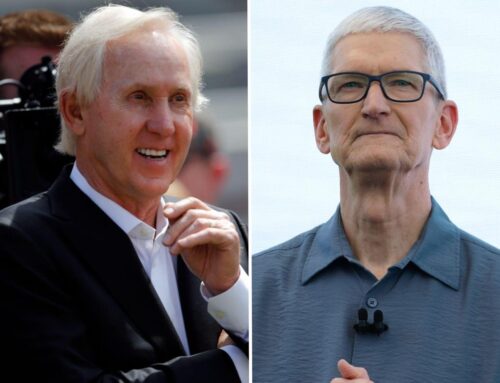The Best Growth ETF to Invest $1,000 in Right Now
April 11, 2025
There are several good ones to choose from, but current circumstances make one fund in particular stand out.
Are you looking to capitalize on the stock market’s recent setback but don’t know which stocks to buy? Don’t make it complicated. Just buy an entire basket of them, in the form of an exchange-traded fund, or ETF. You’ll likely be better off in the long run with this broad-based approach anyway, since picking individual stocks is simply tough to do well for very long.
Growth-seeking investors with $1,000 (or any other amount of money) in available cash they can commit to a long-term trade should consider scooping up a stake in the iShares S&P 500 Growth ETF (IVW -3.86%) over any other alternative. Here’s why.
Unhealthy growth
Don’t panic if you already own a seemingly similar ETF like the iShares Russell 1000 Growth ETF (IWF -3.86%) or the Vanguard Growth ETF (VUG -3.95%). You’re far from doomed. All three of these exchange-traded funds move together, and more or less by the same amount day by day.
As veteran investors can attest, however, given enough time the little things can add up to make a big difference to your bottom line. And the iShares S&P 500 Growth ETF is different from most other comparable exchange-traded funds in one small but important way. That is, the index it’s built to mirror is markedly different — and arguably better balanced — than the underlying indexes of the aforementioned Vanguard or Russell 1000 ETFs.
But first things first.
You likely already know that index investing (or “indexing”) is simply the strategy of holding a broad cross-section of the entire market. In the case of the iShares Russell 1000 Growth ETF, for example, you’re holding a piece of nearly 400 of the market’s biggest growth companies in proportion to their respective market capitalizations. The Vanguard Growth ETF, meant to mirror the performance of the CRSP US Large Cap Growth Index, holds a market-cap-weighted basket of 180 stocks of major growth companies.
Both funds have performed incredibly well since the market hit its pandemic-prompted bottom in early 2020, too, measurably beating the S&P 500 (^GSPC -3.46%) for this time frame.
Data by YCharts.
Most of this strength can be attributed to the incredible gains achieved by the so-called “Magnificent Seven” stocks like Apple, Microsoft, and Nvidia during this period. These of course are some of the stock market’s biggest companies, which means their extreme bullishness has had an exaggerated bullish impact on the cap-weighted iShares Russell 1000 Growth ETF and the Vanguard Growth ETF.
But two old adages come to mind here:
- Nothing lasts forever.
- What goes around comes around.
Translation: The market-cap weighting that helped these two funds dish out superior performances for the past five years may now be coming back to haunt them, if the massive Magnificent Seven companies’ stocks continue to underperform.
The iShares S&P 500 Growth ETF, however, at least somewhat sidesteps this problem.
How the iShares S&P 500 Growth ETF is different, and better
Don’t misunderstand. Based on the S&P 500 Growth Index, the iShares S&P 500 Growth ETF is also a market-cap weighted index fund.
This index is measurably different than most others of its ilk though. Standard & Poor’s not only uses a modified weighting approach that limits the relative size of any single holding within the index, but also ranks and rates potential members based on a somewhat unique combination of sales growth, earnings growth, and each prospective stock’s momentum. The end result is a better-balanced index. For perspective, Nvidia is the S&P 500 Growth Index’s top holding right now, but it only accounts for about 11% of the index’s (and ETF’s) total value. Its second-biggest position is Microsoft, but it only makes up a little more than 6% of the fund’s total value. Apple is its third-biggest holding, but at less than 6% of its total makeup.
The iShares Russell 1000 Growth ETF’s underlying Russell 1000 Growth Index, on the other hand, currently holds Apple and Microsoft as its biggest positions at about 10% of the index’s total value each. Meanwhile, the Vanguard Growth ETF’s top holdings right now are also Apple and Microsoft, with weightings of 13% and nearly 11%, respectively. Nvidia is a close third, yet still at just over 10% of the index’s/ETF’s total value.
This lack of balance isn’t always necessarily a problem. Indeed, as was noted, it was a top-heavy lack of balance that allowed the aforementioned Vanguard Growth ETF and iShares Russell 1000 Growth ETF to perform so well for as long as they did coming out of the worst parts of the COVID pandemic.
Nothing lasts forever though. Now that a slew of the Magnificent Seven’s smaller rivals are finally figuring out how to better compete, don’t be surprised to see stocks of these other companies soon outperforming their better-known bigger brothers. Broad market malaise also poses a bigger threat to its recent leaders, simply by virtue of leaving the market’s more popular tickers prone to more than their fair share of profit-taking.
And for what it’s worth, the SPDR Portfolio S&P 500 Growth ETF (SPYG -3.91%) is based on the same S&P 500 Growth Index, and as such sidesteps the same imbalance concerns.
Respond strategically to the new norm
Again, don’t panic if you already own a stake in a less-balanced growth fund. You’ll be OK. There’s no need to dump that position just to buy this one, particularly if selling something would create an unwanted tax consequence. Wait for a more opportune time to make this strategic shift.
If you’re sitting on some otherwise idle cash right now, however, the argument for choosing the iShares S&P 500 Growth ETF over other options holds water. It remains to be seen exactly how the global economy will respond to the tariff wars thus far, as well as their lingering fallout. So, as trivial as it may seem right now, a little less exposure to the market’s highest-profile names and a bit more exposure to smaller companies actually makes good sense here.
James Brumley has no position in any of the stocks mentioned. The Motley Fool has positions in and recommends Apple, Microsoft, Nvidia, S&P Global, and Vanguard Index Funds – Vanguard Growth ETF. The Motley Fool recommends the following options: long January 2026 $395 calls on Microsoft and short January 2026 $405 calls on Microsoft. The Motley Fool has a disclosure policy.
Search
RECENT PRESS RELEASES
Related Post





